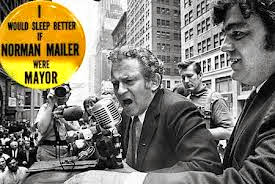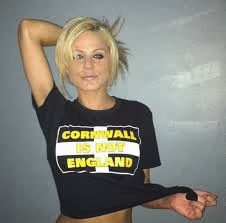The idea of a national identity for the people of
Cornwall,
England’s southwesternmost point and the most obscure of the Celtic nations, is “dead,” according to the chairman of the
English Democrats political party.
 |
| Robin Tilbrook |
The party’s chairman,
Robin Tilbrook, was
exulting over recently-released census data which show depressed figures for those identifying themselves as ethnically or nationally “Cornish.” He added, “The census figures show that not many people are precious about declaring themselves as Cornish. There’s at least five times more people for English nationalism than Cornish.” Only 14% of Cornwall residents in the 2011 census indicated Cornish as their national identity—though that is a more impressive figure when one considers that Cornish was not one of the printed choices and that those 73,200 people Cornish nationals were all write-ins. Moreover, Cornwall has one of the highest rates of immigration from other parts of the
United Kingdom among
England’s counties, and nearly 5% of the population is from immigrant ethnic groups. Given that, the true figures for those thinking of themselves as Cornish first may give greater cause for English Democrat worries.
The English Democrats were founded in the late 1990s (as the
English National Party) in response to devolution of powers to
Scotland and
Wales. On the face of it, they are a devolutionist and Eurosceptical movement favoring removal of England from the
European Union and of course from the U.K. But its true motives are less savory: English Democrats regularly march in white-supremacist rallies alongside
National Front neo-fascists, and the movement is part of a broader movement of Continental European right-wing extremist groups such as
Serbia’s neo-Nazi
Obraz movement, the affiliated
Russky Obraz in Russia (which the English Democrats
publicly support), the
New Right (
Noua Dreaptă) hate group in
Romania, and even
Golden Dawn, the violent, high-profile fascist party in
Greece whose leaders and M.P.s have recently been rounded up by the Greek government.*
 |
| Coming to a Skinhead rally near you |
The English Democrats have no seated legislators and have recently lost ground to the more centrist (but still plenty right of center)
United Kingdom Independence Party (
UKIP), which aims to remove the entire U.K. from the E.U. and currently seats three parliamentarians in the
House of Lords and nine in the
European Parliament’s U.K. delegation in Strasbourg. So the English Democrats are floundering for an edge in the polls. Picking on the Cornish seems especially pathetic and bullying, but that sort of image problem has never bothered them before.
Cornwall has a peculiar status within England. The only English county known formally as the
Duchy of ..., rather than
County of ..., this does not actually translate to any kind of autonomy. It is semantic merely, like
Pennsylvania’s designation as a “Commonwealth” or
Quebec’s parliament being called a “National,” rather than provincial, assembly. But it is also the constituent part of England with the most recent experience with sovereignty.
King Edward III unilaterally annexed to England the previously independent
Duchy of Cornwall in 1337 and designated his son
Edward, the “Black Prince,” as Duke of Cornwall. Since then, that title has been reserved for the first in line to the throne, alongside the title Prince of Wales. Today’s Prince of Wales,
Charles, is thus Duke of Cornwall as well. His specific royal prerogatives include silly medieval stuff like the right to all shipwrecks that wash ashore on Cornwall’s beaches or any porpoises “or other royalle Fishes” caught in Cornish waters, but also more serious assets such as over 540 square kilometers of productive land in and around Cornwall, including enough lucrative farmland to support his lavish lifestyle without dipping into other royal coffers. Cornwall is really Charles’s personal royal fief—and is one day to be
Prince William’s.
 |
| The current Duke of Cornwall is ready to claw the county back if necessary. |
That is, unless the nationalist
Party for Cornwall (
Mebyon Kernow, or
M.K.) has anything to say about it. They argue that the original ducal line, and the Cornish sovereignty it embodied, were never formally extinguished. In 2003, a non-binding referendum showed 55% favored a devolved legislature for the duchy. Others favor being made a full constituent “country” of the U.K., like England, Scotland, Wales, and
Northern Ireland, or a quasi-independent “Crown Dependency” like
Jersey,
Guernsey, and the
Isle of Man. Still others, like the sometimes violent
Cornish Nationalist Party, back full independence.
Cornwall is, along with
Brittany across the water in
France, one of the only two of the seven (as they are sometimes defined) Celtic nations to lack any home rule. (
Ireland is independent—most of it, anyway—while Scotland, Wales, Northern Ireland, the Isle of Man, and
Spain’s region of
Galicia all have powerful regional parliaments, and Scotland is voting on independence next year.) The Cornish language went more or less extinct in the 19th century, by some reckonings, but recently it has been brought somewhat back to life by schooling elders who had dimly remembered passive knowledge of it up to proficiency, with the help of younger speakers of the more-healthy, mutually-intelligible Breton language in northwest France.
Cornish nationalists reacted strongly to Tilbrook’s death certificate, with one local leader,
Wendron Loveday Jenkin, saying, “Most Cornish people define themselves as Cornish and British but not English, and many non-Cornish people living in Cornwall would recognise Cornwall as a land apart, a duchy and a distinct region, if not a nation. A significant number of people have voted for Mebyon Kernow and more than 50,000 have called for Cornwall to have its own assembly to run its own affairs.” And even this does not include the even greater popularity in the county of the
Liberal Democratic Party, now the U.K.’s ruling junior coalition partner, which champions Cornish autonomy.
Indeed, the English Democrats and M.K. are a study in contrasts. Like the separatist movements in Scotland, Wales, Brittany, and Galicia and Ireland’s
Sinn Féin, Cornish nationalists are considerably left of center. Galician separatism even includes a Communist component (though there are, to be far, smaller far-right Scottish and Welsh nationalist movements). The English Democrats, however, have more affinity with far-right separatist groups on the Continent, nearly all of them from the more prosperous parts of their countries, like northern
Italy’s
Lega Nord (
Northern League),
Belgium’s Flemish nationalists, and the fascist-tinged
Norman Movement in northeastern France.
But Lega Nord, for all its racist anti-immigrant bluster, does champion the rights of linguistic minorities such as
Provençal and
Swiss-German speakers in Italy’s northwestern Alpine fringes, and the
Friulian,
Ladin, and
South Tyrolean peoples in the northeast along the border with
Austria. The English Democrats, by contrast, are as intolerant of indigenous diversity as they are of immigrants. They hate anything that spoils the picture of an English unitary state and are even cold to movements to establish devolved parliaments for the
Wessex and
Yorkshire regions.
With high hopes for referenda on Scotland and
Catalonia next year and rising nationalism in Wales, Cornish national identity may in fact be on the upswing. It is the English Democrats who may be headed for the dustbin of history. Good thing, too.
*Note: This article includes a revision of the original version, which featured a statement to the effect that the English Democrats were formally allied with the extremist groups listed in the third paragraph. See comments below for the discussion. Thank you to all readers who provide feedback, clarifications, and corrections.
[For those who are wondering, yes, this blog is tied in with my new book, a sort of encyclopedic atlas just published by Litwin Books under the title Let’s Split! A Complete Guide to Separatist Movements and Aspirant Nations, from Abkhazia to Zanzibar. The book, which contains 46 maps and 554 flags (or, more accurately, 554 flag images), is available for order now on Amazon. Meanwhile, please “like” the book (even if you haven’t read it yet) on Facebook.]





















































